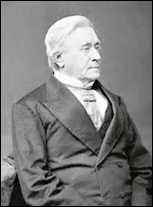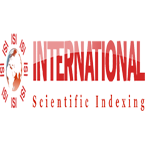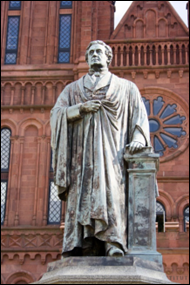Article / Review Article
Chongqing Fuling No.5 Middle School 408099, China.
Wu Xiao Song,
Chongqing Fuling No.5,
Middle School 408099,
China.
13 February 2025 ; 28 February 2025
In history, the first person who discovered electromagnetic induction and self-induction was joseph henry, a scientist from the United States, and he also did a lot of research in other aspects of electromagnetism experiments and achieved fruitful results. In order to commemorate him, people use his name “Henry” as the inductance unit, but there is little introduction to him in the relevant textbooks of middle schools. This paper supplements some related materials and focuses on his scientific contribution to commemorate this great scientist.
Keywords: Electromagnetic induction; Self-induction phenomenon; Henry; physicist.
Joseph Henry (Figure 1) was born in Albany, the capital of New York, on December 17th, 1797. His father, William Henry, was a distant relative of Earl Stirling, but his status was humble and he sometimes took odd jobs. His mother, [Ann, whose maiden name is Alexander, is the daughter of a miller. Willaim henley died young, and little Henry was raised by his widowed mother. My mother is religious and a devout member of the Scottish Presbyterian Church. When Henry was 6 years old, his mother sent him to nearby Golve to live with her stepmother and her twin brother John. After three years of primary school, 10-year-old Henry found a job in a department store. In his miserable childhood, perhaps only the little white rabbit he raised brought him a little joy.

Interestingly, it was that cute little white rabbit that changed his whole life. One day when he was 13 years old, the little white rabbit ran away from the cage. He followed the rabbit in hot pursuit until he caught it in the church. He stood up and was about to go back. Suddenly, he noticed colourful gods painted on the walls, and thick books piled up on the wooden frame. He was deeply attracted. From then on, he hid in the church whenever he was free, reading all kinds of books, and knowledge nourished him to grow up gradually. One day he read Gligorij’s Lectures on Experimental Science, Astronomy and Chemistry published in London in 1808. This is a book on natural philosophy. On the first page, it says, “You throw a stone or shoot an arrow into the air, why doesn’t it fly straight in the direction you gave it?” This fascinated Henry. After reading this book, he is determined to devote himself to science (Loan, 2014).
The owner of that shop was educated, and he encouraged Henry to continue his studies after work. At that time, there was a scientific society in Albany-Albany Institute, whose library contained more than 300 books of all kinds. Henry applied for the position of librarian, and he gave lectures to readers, together with experimental demonstrations. In his spare time, he read priestley’s History of Electricity, became familiar with Coulomb’s research work, and knew about Ampere’s research and Volta’s electric reactor (as a current source). In any case, Henry has spent a lot of spare time repeating those classic experiments as practical exercises. By the time Henry was 36, he was hired as a professor of natural philosophy at New Jersey College (the predecessor of Princeton University). In 1835, Henry was elected as a member of the American Philosophical Society.
In August, 1830, Henry placed a strip-shaped soft iron bar with wires wound between the two poles of the electromagnet, and then connected the wires on the strip-shaped iron bar to a galvanometer to form a closed loop. He observed that when the wire of the electromagnet was connected, the galvanometer pointer deflected to one side and returned to zero; When the wire is disconnected, the pointer deflects to the other side and returns to zero. This is the phenomenon of electromagnetic induction discovered by Henry, which is one year earlier than that discovered by Faraday (1831). However, at that time, the center of world science was in Europe, and Henry was concentrating on making larger electromagnets, and did not publish the experimental results in time. Therefore, the credit for discovering electromagnetic induction belongs to Faraday, who published the results in time, and Henry lost the right to invent.
Henry and Faraday lived in roughly the same age, and the period of their peak research was almost the same. They all come from the same social class, their families are not scholarly brothers, and there is no special way to educate their children. Both of them stimulated their enthusiasm for exploring nature by reading and studying, and embarked on the road of science. Both of them are deeply religious and believe that nature is the masterpiece of the creator. However, Henry works in a small town, with little spare time, limited by funds and equipment, and no scientific research partners. Faraday works in the Royal Institute of England. His conditions are much better. He is in the center of intellectual activities in the world. He has plenty of time to do what he wants, and he is constantly communicating with those talented scientists every day.
When Henry made a comparative experiment on the lifting force of various electromagnets wound with wires of different lengths, he accidentally found that there was an electric spark when the coil with current was disconnected. In August of the following year, Henry studied this phenomenon again. In 1832, he published the paper “Electric Self-inductance in Long Spiral”, announcing the discovery of the phenomenon of electric self-inductance (Jun, 2008) In 1837, Henry visited Europe. As soon as he arrived in London, he took the time to visit the Royal Society and the Royal Institute. Unfortunately, he was on Easter vacation and Faraday was away. But soon, Henry went to Faraday’s lecture, and they met and spent two months with Faraday, which was fruitful and enjoyable. Faraday wanted to do a simple experiment to make the thermocouple spark. He put one end of the thermocouple on a hot stove, and the other end was buried in ice, and the ends of the two leads collided, but it did not produce the expected results. At this time, Henry wound a wire around an iron bar, connected the coil to a lead of a thermocouple, and then collided the two wires, and suddenly a dazzling electric spark broke out. Faraday praised the experiment and asked Henry, “How on earth did you succeed?” So Henry had to explain the truth of self-induction to the scientist who is famous for publishing the law of electromagnetic induction.
In 1827, he wound two layers of gauze-wrapped copper wire around an iron core, and then electrified the copper wire, and found that the iron core weighing only 3 kilograms actually attracted 300 kilograms of iron, far exceeding the attraction of ordinary natural magnets. In 1829, Henry improved the electromagnet invented by the British inventor William Sturgeon (1783-1850) (Figure 2). He wrapped the wires with silk instead of the bare wires of Sturgeon, so that the wires were insulated from each other and wound several layers around the iron block, which greatly enhanced the attraction of the electromagnet. Later, he made a small electromagnet, which could absorb a ton of iron.
 Figure 2: Henry and his electromagnet
Figure 2: Henry and his electromagnet
In 1842, Henry installed a spark gap device in the laboratory, and placed a coil at more than 30 feet to receive energy. The coil was connected with a galvanometer to form a loop. When the spark of the spark gap device flashes, the galvanometer pointer connected to the coil deflects. This experiment actually realized the propagation of radio waves. Although Henry’s experiment was more than 40 years earlier than Hertz’s, people at that time, including Henry himself, did not realize the importance of this experiment. Henry contributed to the invention of the telegraph. He changed the electromagnet into a powerful electromagnet with insulated wires, connected each circuit with batteries in series with relays, and relayed the text signals. One wire in the circuit can be replaced by a ground wire instead of two round-trip wires. Henry once invented a primitive motor like a seesaw. In a sense, this may be his most important contribution in the field of electricity. Because the motor can drive the machine, it is more convenient than the steam engine in starting, stopping, installing and disassembling. Today, the motor has become the symbol of the electrical age. In addition, Henry also improved a primitive transformer and invented non-inductive reactance.
On May 13th, 1878, Henry died in his sleep at his home in Washington. Henry was buried in stony brook cemetery in Georgetown. At the entrance of the castle, a bronze statue carved by Storey stood (Figure 3). Henry made many scientific contributions in his life, but some of them were not published immediately, thus losing the patent rights of many inventions and the priority of discovery. However, people have not forgotten these outstanding contributions. In order to commemorate Henry, the unit of self-inductance coefficient and mutual inductance coefficient was named after him, referred to as “Heng”.
Figure 3: bronze statue of Henry
- Loan, J. (2014). Masters of Physics: From Galileo to Yukawa Hideki (1st e. d.). Shanghai: Shanghai Science and Technology Education Press, https://www.amazon.in/Masters-Physics-Galileo-Yukawa-Hideki/dp/7542859986/ref=sr_1_5?dib=eyJ2IjoiMSJ9. diMl9cMcwLOED1Q7 vy4A20VriXwgevwAQHKOXD7 fnnMlDO29kSbbYU46E3AECUu8_ w62RF6INmMIDnONxuk0A.AG0IF94s1F562_ rmAuoaZhhWTSZJfB6A8PvCO3AVyE&dib_tag =se&qid= 1740542409&refinements =p_27%3Aloan+James&s =books&sr=1-5
- Jun, C. (2008). Discoverer of current self-induction phenomenon-joseph, henry [J] Science and Technology Herald.














